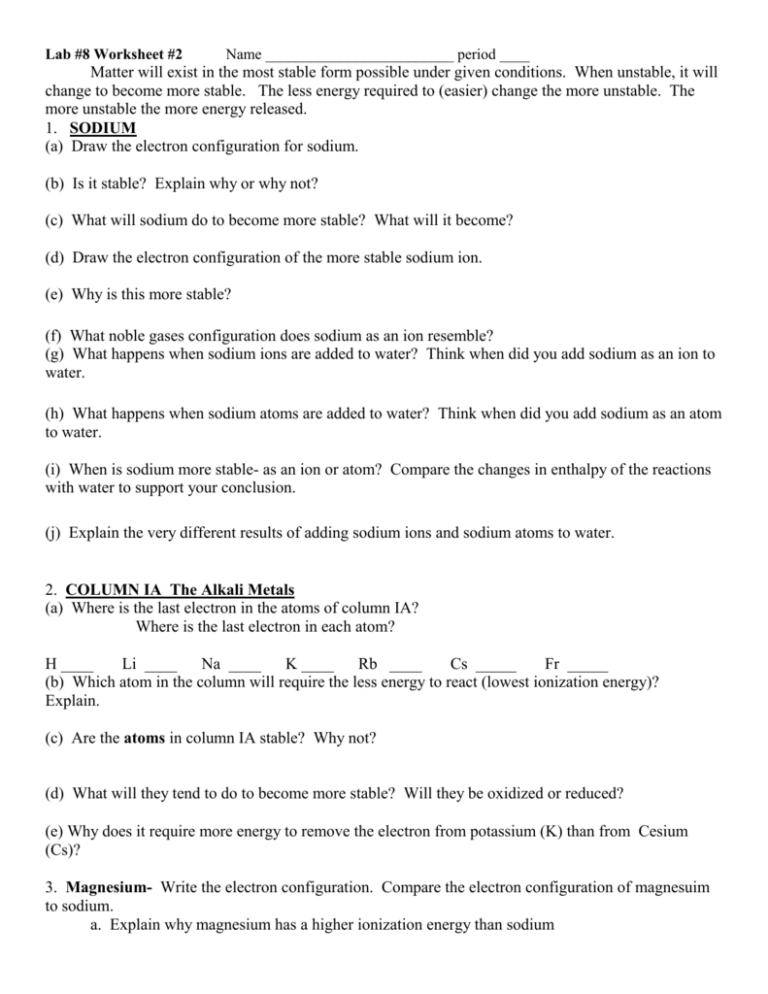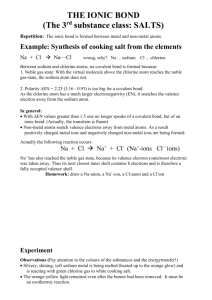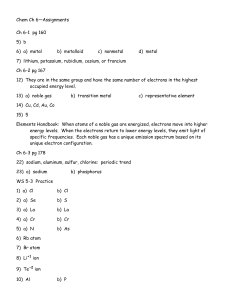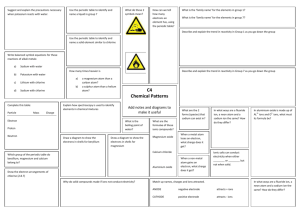Lab 8- ws2
advertisement

Lab #8 Worksheet #2 Name _________________________ period ____ Matter will exist in the most stable form possible under given conditions. When unstable, it will change to become more stable. The less energy required to (easier) change the more unstable. The more unstable the more energy released. 1. SODIUM (a) Draw the electron configuration for sodium. (b) Is it stable? Explain why or why not? (c) What will sodium do to become more stable? What will it become? (d) Draw the electron configuration of the more stable sodium ion. (e) Why is this more stable? (f) What noble gases configuration does sodium as an ion resemble? (g) What happens when sodium ions are added to water? Think when did you add sodium as an ion to water. (h) What happens when sodium atoms are added to water? Think when did you add sodium as an atom to water. (i) When is sodium more stable- as an ion or atom? Compare the changes in enthalpy of the reactions with water to support your conclusion. (j) Explain the very different results of adding sodium ions and sodium atoms to water. 2. COLUMN IA The Alkali Metals (a) Where is the last electron in the atoms of column IA? Where is the last electron in each atom? H ____ Li ____ Na ____ K ____ Rb ____ Cs _____ Fr _____ (b) Which atom in the column will require the less energy to react (lowest ionization energy)? Explain. (c) Are the atoms in column IA stable? Why not? (d) What will they tend to do to become more stable? Will they be oxidized or reduced? (e) Why does it require more energy to remove the electron from potassium (K) than from Cesium (Cs)? 3. Magnesium- Write the electron configuration. Compare the electron configuration of magnesuim to sodium. a. Explain why magnesium has a higher ionization energy than sodium 3. CHLORINE (a) Draw the electron configuration for an atom of chlorine. (b) Is it stable as an atom? Why or why not? (c) What will it do to become more stable? (d) Draw the electron configuration of the more stable chlorine ion. (e) Why is it more stable? (f) What noble gases electron configuration does the chlorine ion now resemble? (g) How does chlorine electron affinity compare to fluorine? Explain why. (h) Draw the electron configurations to show the ionic bond between sodium and chlorine. (i) The chlorine atom is unstable and combines with another chlorine atom to form a diatomic molecule. Draw the electron configuration of two chlorine atom and show the shared pair of electrons. (j) What kind of bond has been formed? 4. COLUMN VIIA The Halogens (a) What is the common electron configuration of the atoms in column VIIA? (b) What will these atoms to become stable? Will they be oxidized or reduced? (c) Explain why the electron affinity of bromine is greater than iodine. Which atom is more stable? (d) Which atom would you expect to release more energy when it becomes more stable? Bromine or iodine? Explain. Which atom is more reactive? 5. COLUMN VIIIA- The Inert Gases (a) Use the concept of stability and change to explain why, These atoms do not react with other atoms. (b) What common electron configuration do these atoms all share?







